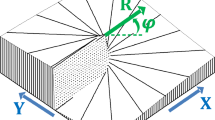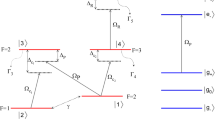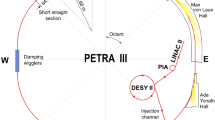Abstract
The motion of channeled particles in a single crystal is determined by the continuous potential of the crystallographic axes. The transverse motion of particles in the axial channeling mode is characterized by a discrete energy spectrum. In this paper, the criteria for selection of the continuous potential and the conditions for quantization of the transverse energy for axially channeled particles are discussed, and the criterion for the resonance capture of particles in the axial channeling mode during particle entrance into a single crystal is formulated; it requires that the particle’s angular momentum with respect to the channel axis coincides with a quantity that is a multiple of Planck’s constant. The effect of resonance capture can be observed, for example, via an increase in the intensity of electromagnetic radiation of the beam of channeled particles in the optical range at frequencies corresponding to transitions between the allowed levels of transverse motion.
Similar content being viewed by others
References
J. Lindhar., K. Dan. Vidensk. Selsk., Mat.-Fys. Medd. 34 (14), 1 (1965).
V. G. Baryshevkii, Channeling. Emission and Reactions in Single Crystals under High Energy (Belarusian State Univ., Minsk, 1982) [in Russian].
S. A. Vorob’ev, Electron Beams Channeling (Energoatomizdat, Moscow, 1984) [in Russian].
N. P. Kalashnikov, Coherent Interactions of Charged Particles in Single Crystals (Scattering and Radiative Processes in Single Crystals) (Harwood Acad. Publ., London, Paris, New York, 1988).
V. A. Ryabov, Channeling Effect (Energoatomizdat, Moscow, 1994) [in Russian].
Proc. Int. Conference “Channelling 2012”, Ed. by S. Dabagov and M. Strikhanov (National Research Nuclear Univ. “Moscow Engineering Physics Institute”, Moscow, 2013).
N. P. Kalashnikov, A. S. Olchak, and E. V. Khangulia., Nucl. Instrum. Methods Phys. Res., Sect. B 309, 67 (2013).
N. P. Kalashnikov, E. A. Mazur, and A. S. Olcha., Int. J. Mod. Phys. A 30, 22 (2015). doi 10.1142/S0217751X15501377
N. P. Kalashnikov, E. A. Mazur, and A. S. Olcha., Phys. Procedia 72, 528 (2015).
N. P. Kalashnikov, E. I. Mulyarchik, and A. S. Olcha., Phys. Procedia 74, 165 (2015).
N. P. Kalashnikov and A. S. Olcha., Nucl. Instrum. Methods Phys. Res., Sect. B 355, 121 (2015). doi 10.1016/j.nimb.2015.02.035
R. P. Feynman, R. B. Leighton, and M. Sands, The Feynman Lectures on Physics, Vol. 3: Quantum Mechanics (Addison-Wesley, Reading, MA, 1963).
N. P. Kalashnikov and M. A. Smondyrev, Foundations of Physics (Drofa, Moscow, 2004), Vol. 2 [in Russian].
L. D. Landau and E. M. Lifshits, Course of Theoretical Physics, Vol. 3: Quantum Mechanics: Non-Relativistic Theory (Pergamon Press, Oxford, 1977).
Author information
Authors and Affiliations
Corresponding author
Additional information
Original Russian Text © N.P. Kalashnikov, A.S. Olchak, 2017, published in Poverkhnost’, 2017, No. 6, pp. 79–82.
Rights and permissions
About this article
Cite this article
Kalashnikov, N.P., Olchak, A.S. Resonance capture of electrons and positrons in the axial channeling mode at a crystal surface. J. Surf. Investig. 11, 646–649 (2017). https://doi.org/10.1134/S1027451017030284
Received:
Published:
Issue Date:
DOI: https://doi.org/10.1134/S1027451017030284




